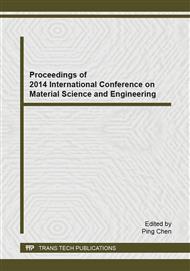[1]
Guan H T, Liu S H, Duan Y P, et al. Investigation of the electromagnetic characteristics of cement based composites filled with EPS, J. Cement & Concrete Cpmpoaites. 2007, 29(1): 49-54.
DOI: 10.1016/j.cemconcomp.2006.08.001
Google Scholar
[2]
Cengiz Duran Atis, Okan Karahan, Properties of steel fiber reinforced fly ash concrete, J. Constr. Build Mater. 23 (2009) 392–399.
Google Scholar
[3]
B. Li, Y. Duan, Y. Zhang, S. Liu. Electromagnetic wave absorption properties of cement-based composites filled with porous materials, J. Materials and Design, 2011, 32(5): 3017-3020.
DOI: 10.1016/j.matdes.2010.12.017
Google Scholar
[4]
Laukaitis A, Sinica M, Balevicius S, et al. Investigation of electromagnetic wave absorber based on carbon fiber reinforced aerated concrete using time-domain method, J. ACTA PHYSICA POLONICA A, 2008, 113(3): 1047-1050.
DOI: 10.12693/aphyspola.113.1047
Google Scholar
[5]
Fu W Y, Liu S K, Fan W H, et al. Hollow glass microspheres coated with CoFe2O4 and its microwave absorption property, J. Jouranl of Magnetism and Magnetic Materials, 2007, 316(1): 54-58.
DOI: 10.1016/j.jmmm.2007.03.201
Google Scholar
[6]
A. Oikonomou, T. Giannakopoulou, G. Litsardakis, Design, fabrication and characterization of hexagonal ferrite multi-layer microwave absorber, J. Magn. Magn. Mater, 316 (2007) 827–830.
DOI: 10.1016/j.jmmm.2007.03.114
Google Scholar
[7]
Meng W, Yuping D, Shunhua L, et al. Absorption properties of carbonyl-iron/carbon black double-layer microwave absorbers, J. Journal of Magnetism and Magnetic Materials, 2009, 321(20): 3442-3446.
DOI: 10.1016/j.jmmm.2009.06.040
Google Scholar
[8]
Li K Z, Wang C, Li H J, et al. Effect of chemical vapor infiltration treatment on the wave-absorbing performance of carbon fiber/cement composites, J. Jouranl of University and Technology Beijing, 2008, 15(6): 808-815.
DOI: 10.1016/s1005-8850(08)60292-3
Google Scholar
[9]
Yuefang Zhang, BaoYi Li, Shunhua Liu, Wanjun Hao. Electromagnetic Wave Absorption Properties and Mechanical Properties of Aramid Fiber Reinforced Cement, J. Advanced Materials Research 2012, 512-515: 2873-2877.
DOI: 10.4028/www.scientific.net/amr.512-515.2873
Google Scholar
[10]
S.M. Abbas, A.K. Dixit, R. Chatterjee, T.C. Goel, Complex permittivity and microwave absorption properties of BaTiO3–polyaniline composite, J. Mater. Sci. Eng. B-Adv. 123(2005) 167–171.
DOI: 10.1016/j.mseb.2005.07.018
Google Scholar


